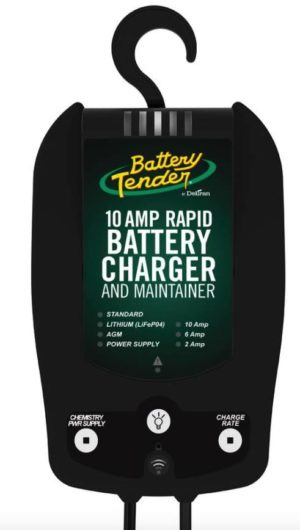Charging with a battery tender…
What to do if your converter doesn’t have a maintenance/tender mode
Dear Mike
I’ve stored our 5th wheel indoors last winter and for insurance purposes I had to remove my two 6-volt Trojan batteries. I’d like to put them on a battery tender for the next winter season. The Trojans are rated for 225AH and my charger is a NOCO Genius 2.
Before charging my test showed 5.7 volts of charge on each battery. I’ve had the first battery hooked up and charging for 3 days now and the tender shows it took 1 1/2 days to reach 25% and 3 days to reach 50%.
Am I doing something wrong? Should I continue to leave the battery charging or will I damage it? Also, is it better to store the battery in my heated basement during the winter, or elevated off the floor in my garage? I’m in Ontario, Canada, and temps locally will hit -10 C (+14 degrees F) during January and February.
Thanks so much for guidance on this. -Terry Smith
Dear Terry,
Okay, here are the basics. First of all, batteries are kind of like a debit card with a deposit limit. So, just like a debit card with a $225 max amount, a 225 Amp-hr battery can supply 225 amperes of current for 1 hour, or 10 amperes of current for 22.5 hrs, or 1 ampere of current for 225 hrs. (more or less, depending on internal battery resistance, etc.). Of course, just like any bank account or debit card, when you take money out, at some point you’ve got to put it back in.
Deposits and withdrawals
Just like dollars on a debit card, those amp-hrs in a battery are pretty much the same no matter if you’re charging or discharging it. That is, you can’t get more amp-hrs out of a battery than you previously put into it. So if you take amp-hours of energy out, then you have to put amp-hrs of energy back in for the future.
Now, this is up to the limit of the fast-charging ability of the battery chemistry, so you probably don’t want to exceed 10% of the amp-hr capacity while charging a flooded-cell lead/acid battery or you’ll warp the plates and boil out the electrolyte. So, probably no more than 20 amps of charging would be allowed for a 225 amp-hr battery. But the basic in/out charge/discharge principles are the same, just like any bank account.
A battery tender is not a fast battery charger
Your NOCO Genius 2 charger/maintainer is rated for a maximum charging capacity of 2 amperes of current. Now, let’s take a look at a SOC (State of Charge) chart. You can see that at 5.9 volts your batteries only have 30% charge left. So you have to put 70% of 225 amp-hrs back in.
A little quick math shows at 0.7 x 225 = 157 amp-hrs of recharging. So if you’re putting 2 amps of current back into your battery, you simply divide 157 by 2, which equals 78 hrs. Let’s round that up to 80 hrs. for general losses, and divide by 24 hours in a day. So 80 / 24 = 3.33 days of charging with a 2-amp charger to bring your 225 amp-hr battery from 30% up to 100%.
Why does it take even longer?
Now, this is also assuming that your batteries are in great shape, and the charger is maintaining a full 2 amps of charging current. But the NOCO battery tender may have determined it needs to limit the charging current to 1 amp or so, in which case it could take 6 or 7 days to charge each battery.
Note that you can certainly hook the batteries up in series and charge both of them at once in the same time you can charge a single 6-volt battery. But that assumes both batteries are exactly matched and have the same State of Charge. Individual charging is still the best method. But when you have them both up to full charge, I would simply connect them in series and use your NOCO battery tender on them for the winter in your garage.
Must… Go… Faster…
For faster charging, if you had something like a Battery Tender Rapid Charger it would automatically charge each battery from 30% to 100% in around 16 to 20 hrs., then go into tender/maintenance mode to keep them safe and happy.
Don’t boil your batteries
Also, remember that a simple battery charger is a pretty terrible maintainer. So if you connect a basic 2-stage 10-amp charger to your battery and walk away for a month, it will likely destroy your battery in the process. You need a 3-stage charger that has maintenance (or float) mode.
OK, everyone. Remember that electricity is a useful and powerful force, so we all need to pay attention to safety precautions while using it.
Let’s play safe out there…. Mike











Since Flooded Lead Acid and AGM batteries can easily loose 10% or more charge per month, storing them over winter without a maintenance charger can result in loss of longevity.
Hi Mike thanks for this article. I have two Lion energy 100ah lithium battery’s but my 5th wheel doesn't have the option for charging lithium batteries and the voltage never gets to 14 bolts. Can I hook up my Victron IP22 30a charger to the batteries while they are still hooked to the trailer to change them and maintain them? And can I leave it on to maintain them? Thanks Tex